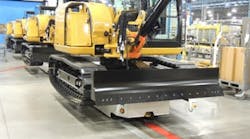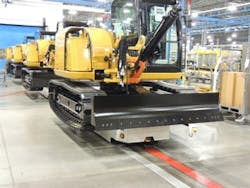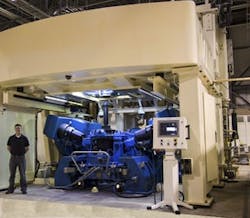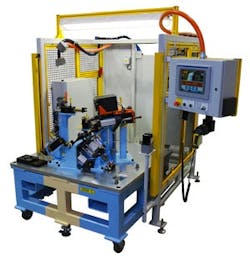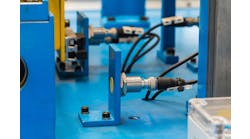Energy costs were low in 2016, which put the brakes on many energy-related projects. And it appears to have reduced interest in machine energy efficiency, as well. Machine builders supply what the end users demand. While energy efficiency may not be the hot topic it was a few years ago, machine builders continue to improve it because it can optimize the machines for more productive operation.
Owens Design in Fremont, California, has many industrial solutions for a variety of high-tech machine applications. "We have had very few requests regarding energy usage on our machines," says Doug Putnam-Pite, director of software development at Owens Design. "Although many of our suppliers are offering more energy-efficient devices, we have not implemented any new energy efficiency programs with regard to the tools that we build."
Some distributors are not seeing many end-user requests for machine energy efficiency solutions either. "I don’t have any specific examples that come to mind," says Kier McNamara, regional sales manager at KEB America. "I don't recall a customer bringing up energy efficiency. We do bring up energy efficiency with our customers related to our line regen systems, for example. Regen systems save energy that would have been otherwise burned off as heat through a braking resistor, and the customers do show interest in returning power to the line-side supply. They give it a thought, but it doesn't seem to be a priority. Fortunately, a VFD or regen system has a payback period that is typically well within the lifetime of the machine."
Owens Design sees more offerings from suppliers regarding energy efficiency in motion and other components that it can use in its designs, notes Putnam-Pite. "However, the pull from the customers has been almost nonexistent to date. I think that, in the United States, the market's need for energy-efficient machines is not as important when the energy costs are low. I think in countries such as Japan, there may be more of a push for energy-efficient machines. Regardless of whether the customer is demanding it or not and despite the low cost of electricity, energy-efficient machines are a good thing."
ALSO READ: A new level of energy efficiency for machine builders, system integrators
Optimization and reliability
Figure 1: RedViking's use of inductive power transfer eliminates the need for a battery in these AGVs, reducing the number of vehicles needed.
(Source: RedViking)
"The end user is looking for energy-efficient machines, but these users are also looking to do more work with fewer machines as a means of saving energy," says Mark Sobkow, vice president of manufacturing solutions, RedViking in Plymouth, Michigan. "We do a lot of projects that focus on adding flexibility so that one machine or cell can do the work of what was done by many machines or cells in the past. That might take the form of a multi-attribute inspection machine or incorporating onboard automation onto assembly-line AGVs by using inductive power transfer (Figure 1). These allow plants to do more work with fewer machines."
It goes beyond more efficient use of machines, as well. "Plant managers’ responsibilities on energy efficiency extend into finding genuinely sustainable options," says Sobkow. "As a result, we’re seeing demand increase significantly for battery-free assembly-line AGVs, since lithium ion and lead acid batteries are so potentially damaging to the environment.” RedViking has also seen a big increase in demand for powertrain test stands that use electrical energy regeneration, because they can recapture up to 80% of their power for reuse in testing.
"One might think that direct cost savings is the ultimate goal for an energy-efficiency plan," says Sree Potluri, I/O application specialist at Beckhoff Automation. "While this is certainly a positive benefit, we often see our customers using it as a means of overall production optimization. By monitoring energy usage in machines, companies are also able to detect inefficiencies which can indicate that part of the process is in need of repair or improvement. For example, bearings in a motor may become worn and use excessive energy due to the added friction. This inefficiency can then be addressed during scheduled downtime, rather than getting hit with a costly breakdown that stops production without warning."
B&R offers both energy and condition monitoring capabilities in its automation platform. "Some end users are currently overlaying these capabilities onto existing production lines to increase operational efficiencies without replacing the existing third-party control systems, says John Kowal, director, business development at B&R Industrial Automation. "Others are adding this capability to existing B&R controlled machinery. Key to plant managers is improving operational efficiency without disrupting production."
It's common to think of using power monitors to measure electrical consumption, typically for a branch circuit, continues Kowal. "But we also apply energy monitoring to compressed air, vacuum, natural gas, water and heat, as in ovens or shrink tunnels, as well as electrical power within machines," he says.
Although sustainability doesn't have the buzz it had a few years ago, corporations commonly mandate plant management with reducing the environmental footprint, as well as production costs, says Kowal. "Water and power consumption are two key areas," he says. "Even a small percentage improvement can have a significant impact with scale and because the savings are ongoing moving forward. The sustainability concept still has great merit, as it combines environmental and cost benefits, a win-win."
Erl Campbell, key account manager at Aventics sums it up well. "The plant managers and end users mostly focus on the large systems in their facility, such as lighting and HVAC. The focus on production lines has more to do with reliability than energy efficiency; however increased reliability can also make machines more efficient. Energy efficiency, reliability and safety are all top areas of concern, and they all help to keep operating costs down."[pullquote]
Real efficiency opportunities
"A big part of improving energy efficiency for plant end users is getting rid of air-powered devices and machines," notes RedViking's Sobkow. "Air power is not an efficient means of transferring energy. Also, air systems frequently have leaks which create energy losses, are noisy and create condensation and mist that are unpleasant for the end users. Electronic drive methods for machines and tools eliminate these issues for end users in the factory."
The easiest changes are being made as a first step, says Aventics' Campbell. "Plants are constantly looking for improvements and savings to be competitive in the market," he says. "The component suppliers are developing products and processes to help support these initiatives, making them easier to implement. Users and suppliers will need to work closely to make energy-efficient solutions that save energy and don’t risk loss of a product’s capacity or reliability."
The idea of energy efficiency has typically been focused on a plant’s highest energy usage—water, air and heat, explains Mike Wagner, global OEM segment leader for packaging, Rockwell Automation. "More recently, packaging equipment has become a target as energy information becomes more readily available," he says. "However, monitoring energy usage or even reporting this information is not enough. End users are increasingly asking for a full energy-reduction plan for their machinery and equipment. Improving efficiency, reducing waste and shrinking machine footprints are all ways to improve energy efficiency."
As an automation vendor, Beckhoff continually introduces ways to improve energy efficiency through advanced measurement and monitoring technologies, notes Potluri. "Of course, the biggest consumers of energy on a machine are high-load motors and drives, air compressors and any heat generators used in production processes, such as for plastics machinery or plasma-cutting machines used in metalworking," she says. "We are seeing greater demand for precision measuring solutions to monitor these and other energy-intensive types of equipment. To serve this demand, we offer a range of new power monitoring hardware and software products."
Efficient AGVs
Figure 2: Energy regeneration technologies recover up to 80% of the energy used in this helicopter powertrain test stand instead of wasting it as heat.
(Source: RedViking)
"With the advent of assembly-line AGVs, conveyance is becoming a lot more energy-efficient," says RedViking's Sobkow. "Instead of running a giant chain-based conveyor that has to be built for maximum capacity, AGVs allow plants to buy only the conveyance they need for the current throughput. Inductively powered AGVs take this a step further by getting rid of batteries, charging stations and extra AGVs (Figure 2)."
RedViking also does a lot with docking station architectures, with the core devices on the docking station and configurable wheeled fixtures moving in and out to accommodate different parts and processes, continues Sobkow. "In the past, you would have seen multiple machines, and you’re obviously expending more energy to run multiple machines," he says. "But even in idle states you’re having parasitic energy loss from PLCs, operator displays, safety light screens and hydraulic pumps. When you put all of those energy-consuming elements on the docking stations and change function with swappable fixtures, you’re eliminating not only energy loss resulting from multiple active machines, you’re also eliminating that parasitic energy loss from supporting multiple machines in passive states (Figure 3)."
Figure 3: RedViking's docking station design accommodates a variety of parts and processes on wheeled fixtures, improving energy and operational efficiency.
(Source: RedViking)
RedViking's energy regenerating powertrain test stands have been a big energy saver. "Where old technology lost all expended energy in wasted heat, energy-regeneration technologies allow a dynamic component test stand to recover about 80% of its energy for reuse or, if their grid can accommodate it, returned to the energy source," says Sobkow.
Energy efficiency is a continuous part of RedViking's process improvements. "We’re always looking for ways to increase flexibility to allow higher utilization rates of equipment, thus reducing idle-time power consumption," notes Sobkow. "On a larger scale, we design and build machines and assembly lines to be flexible enough to incorporate future energy saving technologies."
Easy on the air
"Machines are becoming more efficient by using only the amount of energy required to do the job, says Aventics' Campbell. "For instance, most pneumatic valves use the supply air pressure to assist in the shifting of the valves. Valve manufacturers are reducing the required electrical energy below 1 W in some instances, and Aventics’ new AV valve only requires .55 W to shift the valve. In addition, the compressed air can be regulated on both sides of an actuator to the correct amount to do the work. For example, if it is only necessary to move a load when extending a cylinder but not when retracting it, much less pressure can be used to retract it. The pressure can be controlled by manually adjusted regulators mounted to the work ports of the valve or electronically adjusted using an E/P pressure control valve which can now be configured on the manifold. The advancement of these electronic pressure control valves has also led to the ability to position pneumatic actuators, further increasing the efficiency."
Figure 4: Placing the valve manifold close to the actuator is just one of many ways to improve efficiency.
(Source: Aventics)
Locating valves closer to the actuators is another way to save energy and increase machine performance, continues Campbell (Figure 4). "Even in wash-down applications, valves that are IP69K—high-pressure washdown approved—are available that can be mounted close to the actuators," he says.
Shaun Hendon, a sales engineer at HeiTek Automation, a distributor located in Phoenix, Arizona, who develops, designs, fulfills and supports automation solutions for a variety of industries, provided an example of an energy-saving application. Based on the excellent results in a previous application using Mac Valves' pulse valves product, he is working with a tire-recycling company to retrofit 10 dust-collection systems.
"The typical large dust collectors at a factory consists of a matrix of 12 to 15 cylindrical filter bags that collect the debris," says Hendon. "Periodically, the debris must be removed from the filters when the static pressure rises to the point that the system is inefficient. The controls and pneumatic diaphragm valves on these dust collectors are typically primitive and inefficient. The old diaphragm valves fail often and are not as effective at cleaning the bags as Mac Valves’ spool-valve technology. Also, if just one of the many diaphragm valves fails, which they do often, the plant’s compressed-air supply may not be capable of supplying the flow needed to keep the plant running."
In early applications, Mac Valves' plan was to develop a more reliable valve for use in dust collectors, so it designed a spool valve that would last longer than the legacy diaphragm valves, notes Hendon. "It turns out the new Mac valve did last much longer, but it was much more efficient, as well," he says.
A typical dust-collector-cleaning process shakes the cylindrical bag filters using a stream of air that creates a shock wave that travels along the length of the filter to remove the dust. The legacy valves open slowly, dampening the blast of air. The Mac pulse valves open quickly, creating a stronger shock wave pulse resulting in better cleaning of the filter.
"A more powerful pulse action extends time needed between pulses, which lowers energy costs, says Hendon. "The more efficient and effective pulses from the Mac valve resulted in cleaner filters each cleaning cycle. Less cleaning pulse frequency increased filter life, lowering costs, as well."
The legacy controls on many OEM dust collectors consist of simple timers with no process feedback used, continues Hendon. "The upgrade for the tire-recycling customer will replace these legacy controls with modern Siemens controls and the Mac Valves pulse valves," he says. "Differential pressure feedback will also be added to automatically determine the optimum time to clean the bag filters. This upgrade will provide significant energy savings."
Based on a previous dust-collection application, it is estimated that the standard cubic feet per minute (scfm) used each cleaning cycle could be cut in half, notes Hendon. "Also, the duration of the pulse could be reduce to one-third the amount currently used—half the flow for one-third the amount of time will be the starting point," he says. "Even more impressive is the reduction in the number of cleaning cycles needed."
In a previous application with the old legacy valves, the duration between cleaning pulses was 10 seconds, explains Hendon. "With the new pulse valves from Mac Valves, the duration between each pulse could be as long as five minutes,” he says. "Obviously, these are very significant improvements because, instead of more than 2 million valve cycles per year, the customer could operate the valves fewer than 70,000 pulses. That's energy efficiency, process efficiency and machine efficiency."
Get efficient
"When it comes to machine energy efficiency, end users, equipment suppliers and automation vendors should all work together to achieve the best results," says Rockwell Automation's Wagner. "End users can help to identify waste, while equipment suppliers can design machines that use fewer resources, operate at higher OEE (overall equipment effectiveness) rates and reduce waste. For example, OEMs may design machines that eliminate the use of compressed air by using electric actuators instead of pneumatic actuators. Another example is the use of direct-drive linear and rotary servos in place of belts, pulleys and gearboxes. This single change can reduce energy usage by up to 50%. A third example is to power up devices only when they are required to perform their function, similar to sleep mode in other technologies."
All parties involved should also work to provide clear, consistent and contextualized information at all levels within the facility, continues Wagner. "Operators need to know when something is not working properly so they can immediately fix it," he says. "Maintenance staff must have information regarding issues that may arise before they affect production. Plant managers must have visibility into all pertinent operating parameters. Equipment suppliers must have visibility into the operating efficiency of their equipment in order to make necessary improvements."
Some customers are very tuned in to efforts that reduce utility costs and promote environmental savings, and they experience great success on those counts, says Beckhoff's Potluri. "Energy efficiency initiatives that are applied throughout a plant will deliver an ROI and can generate substantial savings over time, even if those savings appear incremental at first," she says. "I know energy efficiency isn’t currently at the top of every company’s list for cost reductions. There are related benefits that can more immediately affect the bottom line, such as maximizing uptime/throughput and avoiding equipment breakdowns. By closely monitoring the energy consumption of an entire machine, inefficiencies in specific devices can indicate necessary repairs, troubleshooting or other maintenance well before an unexpected downtime event. The efforts also go a long way to optimize throughput and production by increasing equipment efficiency and accuracy."
At its most basic level, saving energy means saving money, says Sobkow. "At RedViking, sustainability is one of our core values," he says. "We’re an ISO 14001 company, so we don’t just help our customers to be better environmental stewards; we’re taking that approach internally, as well."
